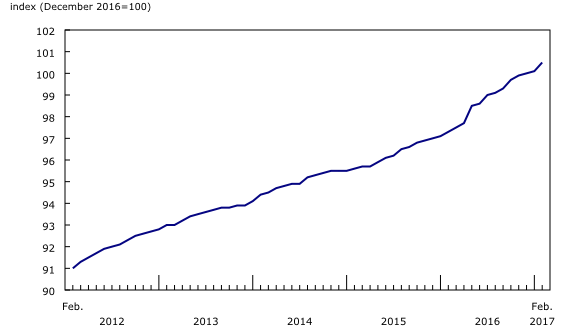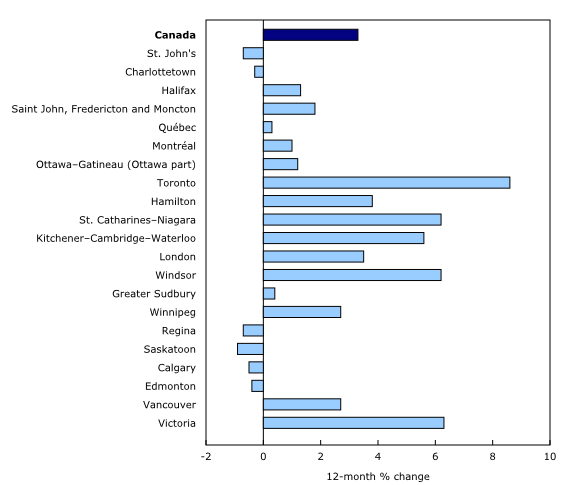New Housing Price Index, February 2017
Archived Content
Information identified as archived is provided for reference, research or recordkeeping purposes. It is not subject to the Government of Canada Web Standards and has not been altered or updated since it was archived. Please "contact us" to request a format other than those available.
Released: 2017-04-13
February 2017
0.4% 
(monthly change)
February 2017
0.0%
(monthly change)
February 2017
0.0%
(monthly change)
February 2017
0.0%
(monthly change)
February 2017
-0.1% 
(monthly change)
February 2017
0.2% 
(monthly change)
February 2017
0.8% 
(monthly change)
February 2017
0.2% 
(monthly change)
February 2017
0.1% 
(monthly change)
February 2017
0.0%
(monthly change)
February 2017
0.1% 
(monthly change)
The New Housing Price Index (NHPI) rose 0.4% in February compared with the previous month. Ontario accounted for the majority of the gain, as new house prices increased in all 10 of its surveyed metropolitan areas.
New Housing Price Index, monthly change
New house prices were up in 16 of the 27 metropolitan areas surveyed, with the largest increases observed in Guelph (+1.4%) and Oshawa (+1.2%). Builders in Guelph tied the increases to higher construction costs, a shortage of developed land, and improving market conditions. In Oshawa, builders cited improving market conditions as the primary reason for the rise.
Toronto was the top contributor to the national gain, with prices up 1.0%. Builders reported moving to new phases of land development, a shortage of developed land and improving market conditions as the main reasons for the rise.
Other notable increases (+1.0%) were observed in Hamilton and Victoria. Builders in both areas reported market conditions as the primary reason for the increase. For Hamilton, this was the largest price gain observed since July 2009.
New housing prices fell 0.2% in Calgary. Although some builders reported higher construction costs, these were offset by lower negotiated selling prices and promotions to stimulate sales. Prices in Vancouver were down 0.1% for the second month in a row.
Housing prices for eight metropolitan areas were unchanged.
New Housing Price Index, 12-month change
On the strength of price increases for new houses in Toronto, the NHPI rose 3.3% over the 12-month period ending in February. This was the largest annual growth at the national level since June 2010.
Toronto recorded an 8.6% year-over-year price increase, the largest among the metropolitan areas surveyed, followed by Victoria (+6.3%), St. Catharines-Niagara (+6.2%), and Windsor (+6.2%). The gain for Windsor was the largest reported since January 1990.
Six metropolitan areas recorded year-over-year price declines in February. Continued weakness in new home prices in Alberta and Saskatchewan accounted for four of the six 12-month declines.

In celebration of the country's 150th birthday, Statistics Canada is presenting snapshots from our rich statistical history.
As part of this release on the New Housing Price Index (NHPI), we look back at the development and evolution of the index.
Statistics Canada has been collecting monthly prices for new housing since 1969. The first indexes measuring housing price change covered single-detached houses in the census metropolitan areas (CMAs) of Winnipeg, Edmonton and Calgary. Builders in these CMAs were constructing a large enough volume of the same house models to report selling prices every month.
Today, the NHPI is based on prices for new single, row and semi-detached house models in 27 metropolitan areas. Edmonton and Calgary still rank among the top four CMAs in relative importance in the NHPI for Canada.
Note to readers
The New Housing Price Index (NHPI) measures changes over time in the selling prices of new residential houses agreed upon between the contractor and the buyer at the time of the signing of the contract. It is designed to measure changes in the selling prices of new houses where detailed specifications pertaining to each house remain the same between two consecutive periods.
The survey covers the following dwelling types: single dwellings, semi-detached houses and townhouses or row homes. The current value of the structure is independently indexed and is presented as the house series. The survey also collects contractors' estimates of the current value (evaluated at market price) of the land. These estimates are independently indexed to provide the published series for land. The index is available at the Canada and provincial levels, and for 27 metropolitan areas.
The prices collected from builders and included in the index are market selling prices less value-added taxes, such as the federal Goods and Services Tax or the provincial harmonized sales tax.
The index is not subject to revision and is not seasonally adjusted.
Changes to the New Housing Price Index
With the release of the January 2017 NHPI data, a number of important changes were introduced to increase the relevance of the index series. The NHPI basket was updated with new weights for the 2017 series and its coverage was expanded to include four new census metropolitan areas: Kelowna, British Columbia; Guelph, Ontario; Trois-Rivières, Quebec; and Sherbrooke, Quebec. The weights used for the 2017 series are based on a price-adjusted three-year average of the value of building completions for each metropolitan area for 2014 to 2016.
Data for periods prior to January 2017 were obtained by linking the new NHPI series, where possible, with indexes in CANSIM table 327-0046.
Separate series are now published for Toronto, Oshawa, Ottawa-Gatineau (Ontario part), Ottawa-Gatineau (Quebec part) and Greater Sudbury. The new indexes for Toronto, Ottawa and Greater Sudbury are linked to those previously published for the following combined cities: Toronto-Oshawa; Ottawa-Gatineau (Ontario/Quebec); and Greater Sudbury and Thunder Bay respectively. A combined Toronto-Oshawa index is available to users upon request for reference year 2017. Thunder Bay is no longer included in the NHPI.
The index base period, for which the NHPI equals 100, is now December 2016.
CANSIM tables 327-0046 and 327-0050 have been archived and replaced by tables 327-0056 and 327-0057 respectively.
Infographic: Producer Price Indexes at a Glance
The infographic "Producer Price Indexes at a Glance," which is part of Statistics Canada — Infographics (11-627-M), demonstrates how producer price indexes for goods and services are calculated and why they are important for the Canadian economy.
Next release
The NHPI for March will be released on May 11.
Contact information
For more information, or to enquire about the concepts, methods or data quality of this release, contact us (toll-free 1-800-263-1136; 514-283-8300; STATCAN.infostats-infostats.STATCAN@canada.ca) or Media Relations (613-951-4636; STATCAN.mediahotline-ligneinfomedias.STATCAN@canada.ca).
- Date modified:



